ISSN: 1204-5357
ISSN: 1204-5357
| Saurabh Mishra Lecturer, Indian Institute of Information Technology, Allahabad. Postal Address: Lecture complex, IIITA, Jhalwa, Allahabad-211012, U.P., India Email: saurabhmishra@iiita.ac.in Saurabh Mishra is lecturer at IIIT, Allahabad. Currently he is pursuing PhD. In the area of ‘‘Marketing ROI in online business’’ from Indian Institute of Information Technology, Allahabad. |
| Madhvendra Misra Assistant Professor, Indian Institute of Information Technology, Allahabad. Postal Address: Lecture complex, IIITA, Jhalwa, Allahabad-211012, U.P., India Email: madhvendra@iiita.ac.in Prof. Madhvendra Misra is Assistant Professor at IIIT, Allahabad, a premier institution in the area of IT & allied areas. He has 12 years of experience in academics specializing in marketing and Business strategy. His current areas of interest are Process management, Consulting and web marketing. |
Visit for more related articles at Journal of Internet Banking and Commerce
This papers explores, usage of Marketing ROI (Return on Investment), in online environment pertaining to key business issues in online marketing function. It chronologically evaluates different practices and avenues of marketing ROI, resulting into the evolution of certain key parameters and their respective methodologies of evaluation. The paper concludes with the proposed framework achieved through standardization resulting out of best practices and prevalent policies amongst corporations operating in the online business scenario.
Keywords |
| E-commerce, Marketing ROI (MROI), Best practices, Standardization, Collaborative modeling |
INTRODUCTION |
| The marketing function over a period of time has evolved as a critical business function to achieve organizational objective. It has been viewed as an effective tool of optimizing business and social goal. Where in an organization is able to achieve substantial gains from its operations even under challenging scenarios of competition and dynamic environmental pressures. |
| The marketing function has often been challenged and criticized for wasteful engagement of the resources, with no effective mechanism of assessment and evaluation of efficiency in appropriate acceptable parameters through quantifiable attribution (Marek Solcansky, Iveta Simberova, 2010).The fraternity of marketers often been questioned and rightfully so about effectiveness of their decision made in context to the returns generated from them. |
| As an observation it has often seen and felt that there is a need of effective measurement criteria as far as marketing function and its related efforts are concerned (Tim Amblers and 2John H Roberts 2008; Rust, Lemon and Zeithmal 2004 ;Srivastav et. Al 2006; David W Stewart 2009). This pursuit over time yields out various sets of methods for assessment considering variety of issues composing the marketing function. The demand and supply differential, sales potential realization, average selling cost, sales force efficiency ,marketing objective achievement including others along with customer satisfaction and contribution to profit have been key consideration in the assessment of marketing effectiveness. |
| These sets of issues as mentioned above which broadly cover different arms of the marketing functions are acting as black box and do not provide sufficient and significant rationale and reasoning towards achievement of the said result, as it has been overwhelmingly seen that theses various functional arms are either complimentary or supporting or contributing in to effective performance or achievement of the other. Thus it becomes difficult to marketers to assess that which particular operational formation has contributed the most, rather at the terminal and in the market place where transaction happens which are the marketing function was the winner, like the product design group, the promotion and related function or the sales force and why not credit should go the flawless distribution of the prices in the market place. |
| These challenge of assessment and evaluation of key pointed references and critical impacting issues in success of marketing function triggered of a debate of researchers and practitioners in the area to demystify the key drivers in the marketing success of any organization. The very genesis of this thought potentially triggered of substantial thinking in the recent time towards objective associated of marketing outcome to specific persuasion of the marketing function. Further granulated into four Ps or recent add-ons in form of seven Ps for the services sector (Christian Gronroos, 1990; Evert Gummesson, 1994). The situation technically challenges conventional marketing wisdom and put across a rider towards associated marketing outcome for result each functional component. This in turn would be the basis of prioritization with reference to fund allocation and other similar decisions to be taken in the marketing parlance. |
| It has been observed in recent years that various quantification methodology has been proposed time to time to understand KPIs, residual analysis ,process centric approaches and other methods including automation to make marketing function more relevant, receptive and responsive to changes taking place in the performing environment of the organization. To the similar persuasion ROI based approaches also found significant consideration and importance both with the research and executive community. The basic premise towards MROI approach was to get a drill down methodology and understand that what marketing resources are able to generate through their effort in execution. |
| The basis of judgment was to have a keen consideration towards investment, and expenditures being made by marketing function in the conduct of their day to day procedures, including: |
| ïÃâ÷ Product Design and Development. |
| ïÃâ÷ Promotion Planning and Execution. |
| ïÃâ÷ Developing and Maintaining Distribution System. Devising Effective Revenue Generation Method through Adequate Pricing Methodology. |
| The marketing ROI based approach seems to have inherently decomposed the marketing function into various sets of independent processes contributing towards achievement of larger interest (Theodore Mitchell, Howard Olsen, 2010; Eric Almquist, Gordon Wyner, 2001). As it may be understood that as a result of regularization or through drill down approach we can adequately identify the process related activity, their control output, resource consumption patterns and process owners as a matter of fact. So regularization through the drill down approach potentially achieved through ROI mind set, can effectively device means and methods to make marketing function not shy away from issues like interdependency, like complexity of its function systems. |
| Thus it will be able to adequately support effective distribution and allocation of funds to those who have been able to contribute in superior goal achievement through their effective execution procedures. The inclusion of internet into the business ecosystem has altogether changed the performing environment and its dynamics. |
LITERATURE REVIEW |
| On the initial edifice of ROI in online perspective is can be well estimated that observing and time line and evolutionary trend and practices may lead us to develop a formal concept matrices regarding ROI and developing understanding and key thrust areas in the function from one phase to another. |
| The scenario through which the marketing function has resorted for online business and related ROI intentions also needs to be evaluated at large. It has been major concern among all the CEO’s and top executive about marketing performance measurement and ability to measure marketing performance. It is found that ability to measure marketing performance effects marketing functions as well performance of the CEOS of the company (Don O Sullivan, ANZMAC, 2009;Rust et al.2004). “Pressure is being placed on marketing to justify their expenditure and translate them into likely financial outcome, which is the language of business firm” (DW Stewart - Journal of Advertising Research, 2009). |
| In 2002 (Accenture's Insight Driven Marketing report, 2001, a study of marketing executives for ROI said that it was biggest challenge in front of marketing executives to find out ROI or how to measure ROI against marketing activities. The study listed the four most prevalent metrics that marketers use: Response Rate (79%), Revenue Growth (78%), Customer Retention (69%), and Profit Generation (69%).The question arises whether these achievements are due to marketing promotional efforts or by other marketing functions. As the sales and service team both claims credit for the same for which marketing could have claim. So it is difficult to find out whether an increased sale is due to the promotional effort or due to the effort of sales team or by customer care team or efforts of channel partners. |
| 90% of marketing executives wants to measure marketing ROI and 80% out of them are not having any method to measure. It is the biggest challenge for marketing executive managers and is matter of concern for them to justify their marketing investment so that further budget could get approve and could justify their role in the organization. The current tools are not capable enough to calculate marketing ROI and marketers are forced to apply it as they are not having any universal method to measure it (Prof. Philip Kotler) .ROI is the critical measures for marketing, but Maximizing ROI does not mean maximizing profit (James D. Lenskold) ROI tools helps management in making decision at corporate, marketing and at campaign level. Companies have been observed to focus more on short term goal or ROI not for long term ROI as it is very critical to measure the ROI for long term impact like customer satisfaction, brand building, corporate image & customer satisfaction, even these are also very important activities which help to gain profit in long term.ROI can be calculated in simplest form: |
 |
| Here investment represents marketing expense & NPV profit & expenses is resulting flow of profit and expense. As per by James D.Lenskold ROI can be measured & justifying by considering theses three components: |
| Customer Life Time Value. |
| Total Number of Customer. |
| Marketing Expenses. |
| Customer lifetime value is net present profit generated from the customer against the marketing investment and it captures buying behavior of the customer that can be valuable measurements for the marketing investment. |
| Total number of customer is number of customer retained or added or generated due to marketing activities. This is basically lead generated from the marketing activities or number of customer interacted on that basis we can calculate number of sale generated and customer added. Theses customer interaction could help to compare the outcome with other marketing activities, through which it is an easy to know the impact of these marketing activities. With help of customer life time value and number of customer we can calculate cost per sale and lead generated and converted and can make benchmark for performance improvement. The improved CRM technology & businesses intelligence help marketers to make data more accessible. By using CRM technology marketers may focus more on highest value customer which in case miss opportunity with other customer segment which in case there would be increase average customer life time value but decrease no of customer which would again lead ROI analysis less profitable. |
| In today’s world there is lot of marketing investment is happening and everybody is concerned about the return on that, apart from other investment it critical to measure return on marketing investment.ROI is matter of concern for all the marketers since last decades; Marketing ROI can be defined as amount of profit against amount of resource. Hawthorne (2004) says marketer should either look at MER (Media efficiency rate) or profit margin against investment to know about the MROI.It is evident that most of the marketing ROI has been calculated for short term (Which gives immediate result against investment) like sponsorship, promotions & discounts & not for long term (Which do not yield financial return immediately rather takes months and year). |
| Marketing investment can be either in offline environment or in online environment. As technology has been changing over decades most of the marketers are focusing in online marketing activities like website promotions etc. In 1990 BMW had started its promotion in online business environment assuring that they would expect ROI against these expenses. They developed a tracking system & find out the number of hits on the web site (reported as over 9 million hits in the first few months) but the question arose whether hits means conversion or something else and could not meet the financial gain. (Rob Dub off is CEO of Hawk Partners).William Duffy (2004) Managing director and partner of marketing analytic services, Burlington says that it is easy to calculate MROI by adding all media campaign cost and comparing it with profit margin & revenue earned which is associated with product or services. |
| Bill Murphy (senior vice president of Marketing & Development of Schaumburg) says that MROI can be calculated by counting response rate, purchase made by the respondent and leads converted & lead generated against the investment for the campaign. This can only calculate the profit earned during the campaign. what about the others who were not visited but come to know during walking or roaming and planned to buy in future? Which is exactly due to the campaign? Anne Klein says (MHS fall, 2003) Marketing ROI is best tool to find out best place to invest in marketing. It is difficult to calculate ROI as it is very difficult to track says Anne Klein, MROI start from your campaign and need to track response around the campaign. |
| Once tracking system is developed well to know about the response in terms of revenue or in terms of awareness then the next step is to calculate the following variables: |
| ïÃâ÷ Expense of the Program |
| ïÃâ÷ Revenue Generated |
| ïÃâ÷ Profit Earned Contribution Margin. |
| ROI can be calculated in form of Percentage, Ratio or as a Breakeven/Pay back method which all are the financial methods of calculation of MROI. It is noted previously that marketing activities has both long term as well short term gains while business organization could only calculate short term gains not long term gain (Steven H. Seggie etl, 2007). As long term gain gives more wealth for business organizations and marketing has to think towards long term gain calculation rather shorter one. It is not easy to calculate brand image or loyalty of customer which do not change in shorter period as yields financial outcome later by increasing customer retention and acquisition (Mark Solcansky).David W. Start says in his research paper that the marketing ROI has been major concern for each and every business organization as well as for academician. There has not been yet developed any standard methods or metrics to calculate marketing ROI .David finds in his study that each and every organization have its own method of calculating marketing ROI or return on Marketing investment, but in most of the cases 70% of Marketing officers could measure to short term impact of marketing activity not for result which is expected to after some period of time. He also categorized marketing ROI basically two categories: |
| ïÃâ÷ Short Term Performance Evaluation. |
| ïÃâ÷ Long Term Performance Evaluation. |
| Short term effect of marketing activity can be generated with help of promotional campaign like price discount or on spot sale which can be calculated either in case of long term impact of marketing like Branding; Float activity etc.It is not easy to calculate as such campaign as they cannot yield result instantly. The question arises again for the organizations that from which point they should start to calculate ROI for such campaign as organization are not having any bottom line or start point to calculate the ROI. |
| Dorian Selz &Petra Schubert (1998, 1999) discussed about effectiveness of e-commerce web site by taking into account B2C e-commerce business model (Amazon, Barnes and Nobel,e-Bay) and developed criteria for evaluating web site with help of web assessment scale. Web assessment criteria considered specific characteristics of book store web sites. Extension of similar work was done by Dorian Selz and Petra Schubert in 1998 by evaluating strength and weaknesses of the existing web site for further improvement and described four phases of e-commerce web site from customer’s point of view which is information phase, Agreement phase, Settlement phase and Community development component.Olsina et al.(1999) Proposes web site quality evaluation method by using hierarchical system of attributes (functionality, usability, efficiency and site stability) to assess the quality of academic web site in general which is beyond the scope of the research. Chang Liu and Kirk P. Arnett (1999) Explored factors associated with web site success in context of e-commerce web site. They have given four major factors for web site success in context of e- commerce web site which is Quality of information and service, Playfulness, System design quality and system use. |
| Talked about marketing performance measurement in context of e-commerce web site on the basis of specific characteristics of web site. |
| Christian Bauer and Arno Scharl (2000) proposed method of automated web site evaluation to asses thousands of web sites without intervention of human intervention by using fuzzy modeling techniques. Attribute given by Olsina (1999) has been taken in consideration. Daniel Cunliff (2000) reviewed existing web sites from usability point of view by considering by considering visual appearance of web site, usability of web site and users need. Focused which web site is better oriented towards users needs. Daniel Cunliffe (2001) evaluated museum web site from users point of view by taking into consideration of web sites content, reliability, easy to navigate, accessibility etc. Lee (2001) said that internet is powerful, transforming and disruptive technology which promises long term potential. E- commerce are taking place rapidly and it has to evaluated on the basis of five essential steps they are: Redefine the competitive advantage; rethink business strategy; re-examine traditional business and revenue models, re-engineer the corporation and Web site; and re-invent customer service. |
| Barua et al. (2001) discussed about financial performance of e-commerce business by taking into consideration operational expenses, did not explained well and examine in terms of marketing ROI, even financially calculated online revenue. Coyle and Thorson (2001) asserted that performance of an e-commerce web site should be assessed on the basis of number of visitors who visits the web site and spend time on searching and discussed about interactivity and vividness of e-commerce web site. Geyskens et al(2002) mentioned that corporate web site enhances the business and provide direct benefits in terms of e-commerce sale and was talking about demand and supply (Olsina et al. 2002) developed quantitative evaluation of web site by using web quality evaluation method for e-commerce web site and find out best and worst qualified web sites from customers point of view. |
| Grembergen et al. (2002) said that cost is associated with developing, designing, maintaining and implementing the web site of e-commerce web site and performance measurement is one of the most important aspects of e-commerce business. Merwe and Bekker (2003) find that no generally accepted methods exist for the systematic and comprehensive evaluation of web site performance. Developed methodology for evaluating e-commerce web site on the basis of five parameters each divided in five sub parameters, which is very much similar work done by Olsina in 2002. Ron Kohavi et al. (2003) described analysis to improve e-commerce web site and given several recommendations that is found to be very useful in practice. Taken into consideration various aspects from customers’ point of view like customer signature, session, usage analysis and conversion rate. |
| F.J. Miranda Gonzalez & T.M.Banegil palacios (2004) evaluated quantitatively commercial web sites (e-commerce) of Spanish firm by using web assessment index. Taken into consideration four characteristics of web site which is Accessibility, Speed, Navigability and content. Proposed method is similar to Merwe and Bekker (2003) and Olsina et al. (2002).Coral Calero et al. (2005) developed web metrics by using web quality model. Proposed most important metrics for web information system. It was found that 44 percent of metrics are related to presentation and most metrics are usability metrics. Levenburg (2005) findings suggest that while a majority of retailers use the Internet to enhance company image, greater pay-offs come from offering more online services, particularly those that may be used by customers in the acquisition process (e.g., e-mail and online ordering) and for post-purchase support. Charles Oppenheim and Louise Ward (2006) discussed how to evaluate e-commerce web site and what makes a good web site. Aspects evaluated included presentation, content, accessibility, language, navigation and structure, transaction page, security and marketing factors. This is more or less similar to work done by many authors in the past. Smits and Bischops (2007) proposed model is given for general web site not for e-commerce web site and help to view website from different perspective like financial perspective, customer perspective and organizational perspective. Fisher &Tia (2009) talked in terms of ROI for social networking sites, focused to measure attributes attention, interaction and conversion index. |
| Where we find that new opportunities in the cyber world, new set of production services & newer customer group has been key movers in motivating organizations to move into this frame of reference. The scenario of competition with changing dynamics both at the buyer and seller and including challenges at the substitution level along with threat posed at the entry and exit level has also definitely being a reason for organizations to think beyond the current paradigm embraced online business scenario at new perspective, which was welcomingly adaptive and responsive the new need of marketing community. |
| The E-commerce with its revenue model along with the value delivery proposition of the organization provided significant tool hold to new organization venturing e – business. Who could have been of either generous belonging too: |
| ïÃâ÷ Brick to Click |
| ïÃâ÷ Click to Brick |
| ïÃâ÷ Only Click |
| This transformation of real world brick organization to virtual world click organization was a new phenomenon all together, where asking question, seeking information, looking out for better deal, ruthless competition and easy comparison were the new order of the day. |
| This scenario based indicative issues significantly touched upon creative functional thinking at the maker end also triggered of development & deployment of innovative technologies which not only ease the transaction processing but also provided relatively high degree of assurance regarding issues of privacy, data security and transaction. |
| Having evolved a transaction and revenue system along with a value delivery mechanism, enabling transactions, inducing satisfaction and efficiency levels of individual users, customers and at the affiliated party along with a regime of online transaction through secure panels. |
| This initial transaction revenue model and transaction processing system (TPS) have bought the online business to initial degree of saturation and when in the historic dotcom bubble bust was also insight of early innovators which sincerely induced in our thinking in online business regarding new business models apart from B2B,B2C,B2C to have more organized and sophisticated system in place like –The customer exchange ,specialty stores resulting into diversified practices and methodologies generating clear cut indicatives for diversification in over crowded market in the cyber space. The presence of multiple operator with in similar interest willing to approach same set of customer ,induced the scenario of competition in the online business, giving rise to methodology of measurement and evaluation of like metrics, Balance score card and ROI extra. |
METHODOLOGY |
| The current research in based on following qualitative assessment methods where in different ROI standards were used by different organizations in online business as published through secondary source in form of reporting’s from industry research paper and other set of best practices would be taken up individually and classified according to the treatment criteria that is the attribute classification methodology and the association rule including the coverage and from time component. |
| A summery metrics which may be called as ROI standard signature for different corporations would be developed where from referral of master metrics would be generated for all standard procedure of ROI calculations used in online business for a specific model that is specific revenue model and specific vertical, divided on the basis of the type of product services, consumer and the type of business and services like etailing- mall, customer exchange, reverse exchange-auctions and e-portals extra. |
| The approaches would be to use weighted average and priority scale to generate effective contributing agent for overall business in online system across different type of revenue model, business model and the nature of enterprises. |
FINDING ONLINE MARKETING APPROACHES |
| The majorities of articles in the concept matrix developed for online business only discusses about the criteria of successful web site or provide web assessment method to calculate web site performance from users or customer points of view based on certain features (Table1). |
| None of them talk about how much financial conversion takes place due to web optimization process and it is said that web optimization will increase number of visitor and conversion. None of the articles discussed about how to calculate online marketing ROI for e-commerce website. |
| It is clear that majority of researches has been done in the area of e-commerce (71%), 24% of literature discussed about general website and only 5% focused only social networking sites (See figure 1). |
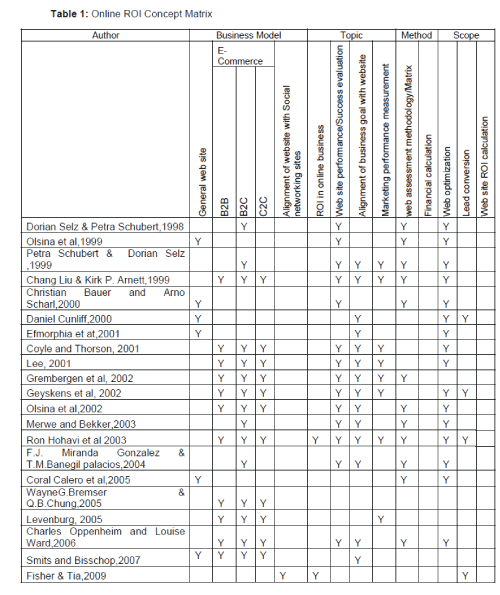 |
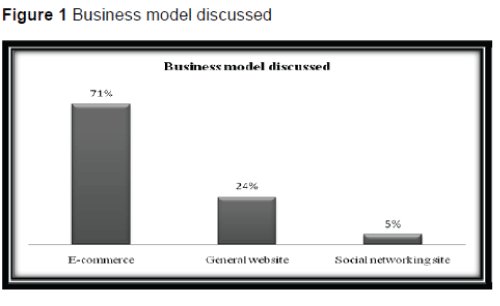 |
| It is clear that 67% of literature discussed about performance evaluation of web site and alignment of business goal with web site.38% discussed about marketing performance measurement (See figure 2). |
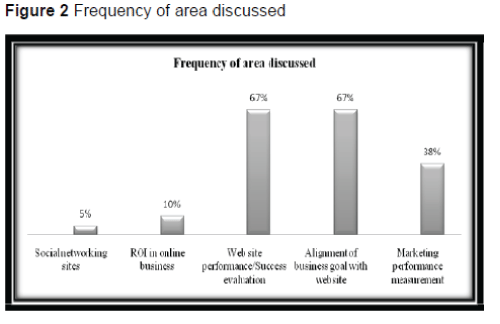 |
| It is evident that 76% authors were concerned more about web optimization or process optimization of the website, 19% were discussed about lead conversion which is taking place due to web optimization. None of the authors talked in terms of ROI or discussed about marketing ROI in online business, the majorities of articles discuss only the criteria for successful websites or provide a method or model to measure the success of the web site (See figure 3). |
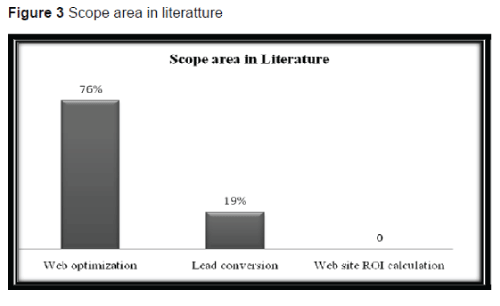 |
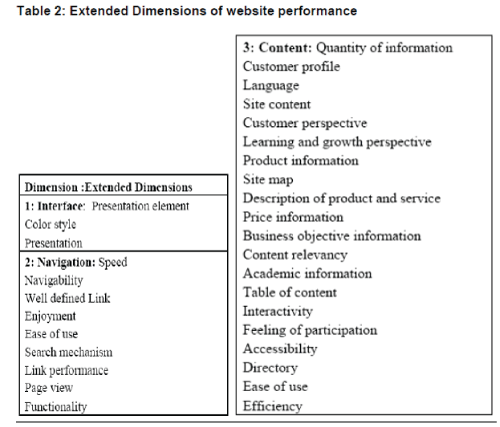 |
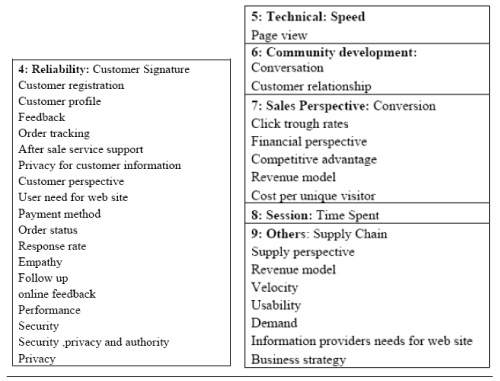 |
| Extended dimensions for e-commerce websites (See table 2) has been categorized in nine categories (See figure 4).Majority of authors discussed about content (30%) for ecommerce website for performance measurement then reliability further to navigation and interface. Content and reliability were considered as a main factor by the authors for assessing website performance and which is the part of web optimization process. It is assumed that improved website through web optimization process will increase web site performance automatically. |
 |
MARKETING APPROACHES IN GENERAL |
 |
| From the concept matrix developed for marketing ROI in general, it can be concluded from the matrix that the term ROI has been discussed in marketing literature. Most of them address the need for ROI in marketing and about marketing accountability towards finance. Some articles only give insight in the need for ROI and provide guidelines how to make marketing more financial accountable. Out of ten articles only article by Rust et al, 2004 measures marketing ROI in financially. Rust et al, 2004 applied concept of CLV (Customer Life Time Value) to measure ROI and quantify the impact of a marketing activity on the perception of a customer. |
| To implement the model proposed by Rust et al (2004) number of information is required like customer contribution margin, frequency of purchase and volume of purchase for industry in consideration and of competitive brand, which is practically not possible to collect the information of the competitor at the desired level. Apart from one brand was in consideration by assuming marketing is stable which is also ideally not possible (See table 3). |
| Berger et al. (2006) and Srivastav et al. (1998) tried to project CLV of marketing activities. Stewart (2009) and Ringham (2005) discussed about the marketing accountability and proposed model for calculating marketing outcome financial with help of intermediary and by considering shareholder value. |
CONCLUSION |
| The importance of measuring marketing performance is addressed in the literature and how important is measuring marketing outcome has also acknowledged by the authors and by the people from industry, but only few of them could succeed to add value towards the marketing measurement for the organization. |
 |
| Numbers of variables has been discussed to optimize the website or to increase the ROI of websites but none of them could measure it in monetary units. Researches have been restricted to web optimization process, while discussing about web site performance for e-commerce. Web optimization is one of the drivers of website marketing for performance improvement while other drives which are also equally important for assessing website performance is not taken into consideration, like Advertising, Distribution, Online promotion, Customer e-mail, Conversion rate, Interstitials, Targeted Banner & Search engine. Web optimization is not only measure that determine of online ROI. |
| The methods Provided by Rust et al.(2004) for measuring marketing performance in monetary terms is practically difficult to apply to calculate ROI of online business. So there is need to develop standard method to measure online marketing performance. |
References |
|
Copyright © 2025 Research and Reviews, All Rights Reserved